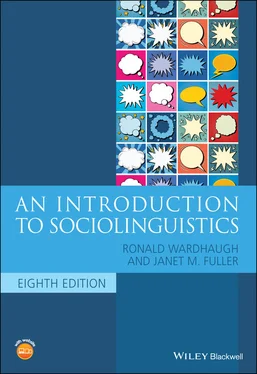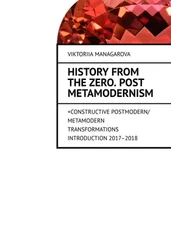The study of nonlinguists’ ideas about the regions, features, and values of dialects has come to be called perceptual dialectology (Preston 1989, 1999, 2002a, 2002b; Niedzielski and Preston 1999; Long and Preston 2003). The methodology employed by Preston in his work involved giving people maps of the United States and asking them first to draw dialect regions, and then to label the dialects and describe them in terms of both correctness and pleasantness. What emerges from such work is an understanding of the attitudes people have about the ways of speaking associated with particular regions. It also reveals stereotypes concerning people who live in these regions. Among various interesting findings in these studies we see that speakers may not rate their own dialect highly, and that many dialects (including the speakers’ own) are sometimes rated highly for pleasantness but as lacking in correctness, or vice versa. For instance, the findings in Preston (1999) show that respondents from Michigan consistently rated their own dialect as correct, and perpetuated the stereotype of southerners as speaking incorrect English. However, the Michiganders often rated southern speech as pleasant and friendly (often more friendly than their own regional variety).
One of the interesting findings in some research in perceptual dialectology is that regional differences are often intertwined with ideas about other social groups. For instance, Bucholtz et al. (2007) found in a study done among University of California–Santa Barbara students about perceptions of language in the state of California that although the southern California/northern California divide was prominent for most of the respondents, and stereotypes about the English spoken in these regions abounded, often other factors emerged as significant as well. Speakers of Spanish (mostly referred to as ‘Mexicans’) were often associated with Los Angeles and San Diego, and speakers of Chinese with the Bay Area. There were also certain areas associated with speakers of AAVE (the Bay Area and Compton, a largely African American suburb of Los Angeles), but this was less frequent than the references to speakers of Spanish. An interesting finding was that the most common social label was ‘hicks,’ or other synonymous terms such as ‘hillbillies’ or ‘rednecks’; the authors note that earlier studies have not shown this category to be associated with California by non‐Californians.
Further, a more recent study has shown that ethnicity may influence perceptions of dialect regions themselves. Alfaraz and Mason (2019) compared results in a perceptual dialectology study of the results from European American and Latinx students at a Midwestern University. While the identification of the South by the European American students aligned with previous studies, the Latinx students identified this region less frequently, and for those who did identify it, there was less agreement about its boundaries. This study indicates that members of different ethnic groups may not share attitudes about dialect regions, and thus may also have different ideas about the people who use particular dialects.
Not all perceptual dialectology research uses maps; in some cases participants are asked to evaluate different varieties simply based on a label of a way of speaking. Alfaraz (2002) asked respondents to rate the pleasantness and correctness of various Latin American varieties of Spanish, a variety referred to as Peninsular Spanish, and two varieties of Cuban Spanish, representing the Spanish spoken before and after the Cuban Revolution of 1959. These findings also illustrate the importance of other social factors intertwined with region in the evaluation of speakers of different social groups. Alfaraz found that association of a particular variety of Spanish with speakers who were of low socioeconomic class or were Black correlated with less positive evaluations of the variety. The pre‐Revolution Cuban Spanish, the variety spoken by the respondents in this study, was evaluated the most positively.
Studies in perceptual dialectology show us that people have far more nuanced beliefs about dialects than simply that they are either ‘good’ or ‘bad.’ Further, most people have a more sophisticated understanding of social groups, incorporating information about region, social class, race/ethnicity, and many other levels of identity.
The matched guise technique was developed to elicit attitudes indirectly (Lambert et al. 1960); in this methodology, research participants hear the same person speaking in two different varieties and rate them on various personal traits, normally using a seven‐point scale. These traits typically include descriptors related to solidarity such as kindness and attractiveness as well as characteristics related to prestige, such as ambitiousness or intelligence. Participants are not informed that they are hearing the same person in two different recordings; the idea is that differences in ratings reflect research participants’ attitudes about the languages and the people who use them. A variant of this, the ‘verbal guise’ (Cooper 1975), uses different people for the different varieties.
A study on Paris French (Secova et al. 2018) used a mixture of direct and indirect methods to study attitudes among youths toward colloquial Parisian varieties. The research participants were themselves residents in the multiethnic, multicultural area of suburban Paris, and their evaluation of speech samples from this area showed not just affiliation and disaffiliation, but also a particular identity indexed by the linguistic features used in this variety: a streetwise, immigrant, or mixed‐heritage persona. The attitudes of these language users to the speech of their ingroup showed that they did not embrace the positive attitudes about ‘posh’ varieties, but valued their own variety and the social identities it indexed. We return to this topic in chapter 8in our discussion of multilingualism.
Implicit association task (IAT)
The IAT is a method which has been adapted from social psychology and is designed to measure the strength of associations between particular concepts and categories. The task presents questions in ‘blocks,’ that is, groups of questions where the left and right buttons are used to categorize stimuli as, for example, good/bad, or insects/flowers. The ease, and thus the speed, of the categorization indicates to what extent the research participant finds the concepts congruent; thus the data makes use of reaction times of responses to show implicit associations. Campbell‐Kibler (2012, 755) provides this example:
Consider the task of sorting items into the two dichotomies insects/flowers and good/bad. Through the experimental procedure, some of the blocks involve the participant pressing the left hand button to select insects and bad and the right hand button to select flowers and good. In other blocks, they are asked to press the left hand button to select insects and good and the right hand button to select flowers and bad. To the extent that the participant prefers flowers over insects, flowers and good will resolve itself into a more coherent shared category, as will insects and bad, compared to the alternate arrangement. These shared categories allow for easier, and therefore faster (and less error‐prone) responses in that condition. The difference in response times across the two combinations thus can be taken to represent a measure of implicit connection across the two dichotomies.
The stimuli for this task can vary and may include sound clips, as is relevant for sociolinguistic studies, and may be matched to categories or judgments such as ‘I like’ or ‘I don’t like’ (Rosseel et al. 2018). Thus this task can measure broad attitudes to varieties, or see how the linguistic stimuli correlate with other features such as region or occupation of the speaker.
Читать дальше




![Andrew Radford - Linguistics An Introduction [Second Edition]](/books/397851/andrew-radford-linguistics-an-introduction-second-thumb.webp)







